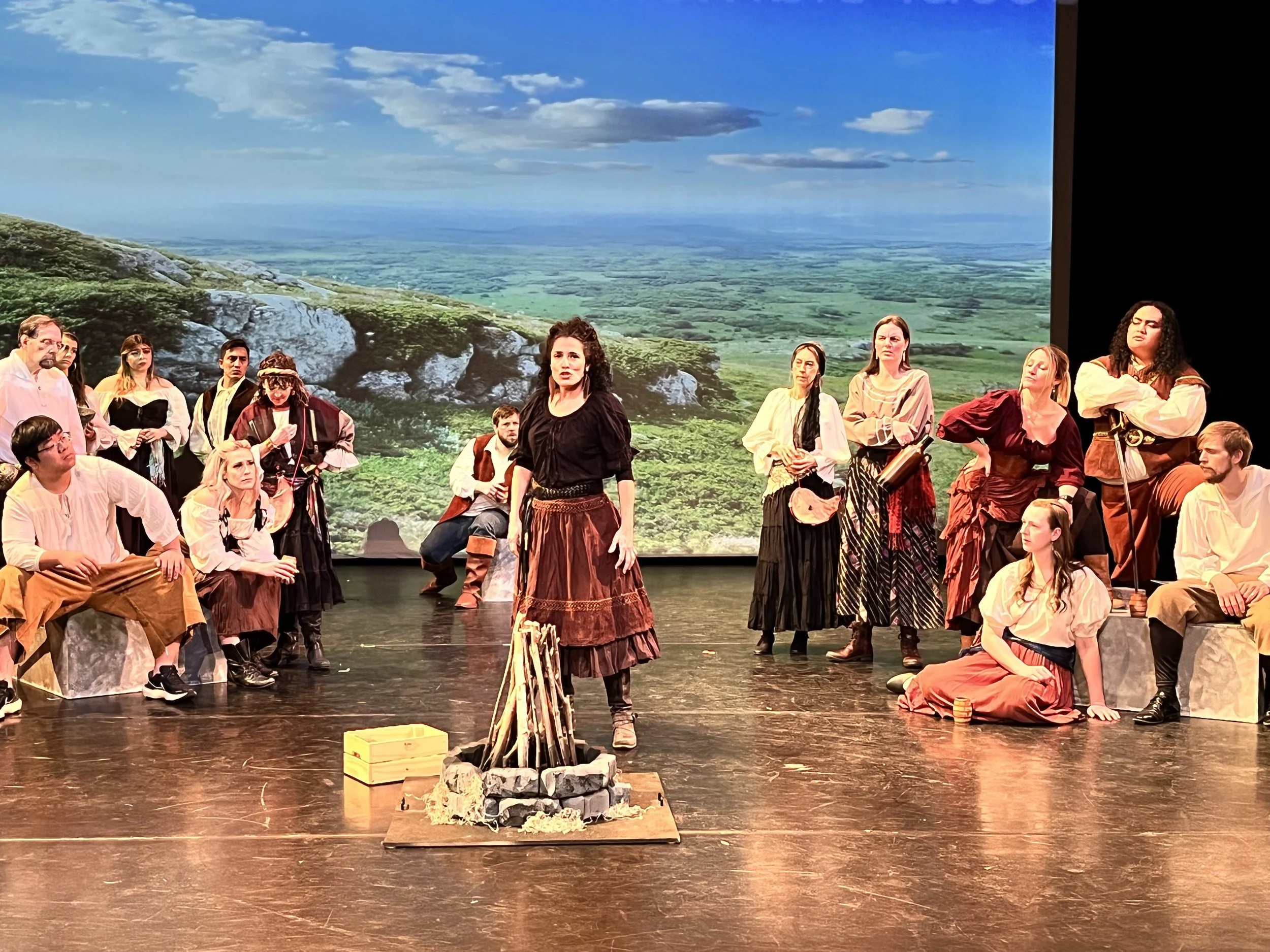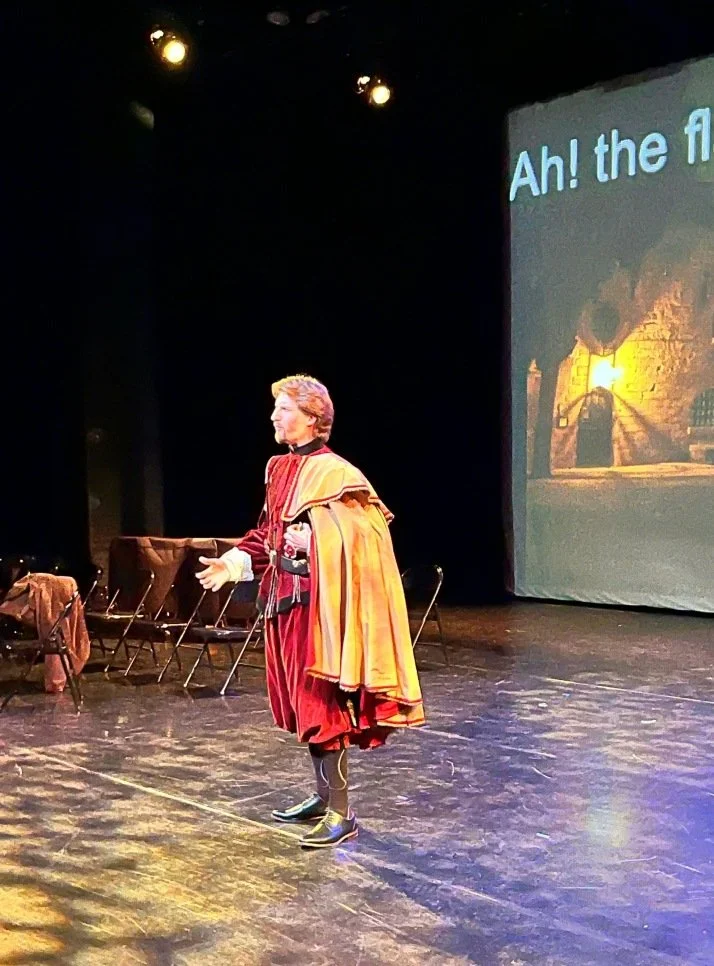Performances will be at the Dairy Arts Center March 19 and 20.
By Izzy Fincher March 15 at 12:15 p.m.
What is the secret to pulling off Verdi’s Il trovatore? According to the Italian tenor Enrico Caruso, it’s easy—as long as you have “four of the greatest singers in the world.”
As part of their 10th Anniversary Season, the Boulder Opera Company will present Il trovatore (The troubadour) March 19 and 20 at the Dairy Arts Center. With scenic projections, a reduced orchestra and a chorus, this four-act opera is one of the company’s most ambitious, large-scale productions to date.
Azucena (Dianela Acosta) in the Boulder Opera production of Verdi’s Il Trovatore
Il trovatore is a hard opera to present, with four principal roles that require large, dramatic voices and demanding vocal techniques. This is especially true for the lead female characters. The Romany woman Azucena (played by Dianela Acosta) needs a lyrical yet dramatic mezzo soprano with a large range, while noblewoman Leonora (Michelle Diggs-Thompson) needs a coloratura soprano voice that is both flexible and hefty.
“Now that I have been singing for a while, I think that Verdi has kind of settled in my voice,” Diggs-Thompson says. “I don’t think I would have been able to pull off this role 20 years ago.”
Beyond this, the opera poses an artistic challenge—that of bringing to life an impossibly melodramatic storyline with twisted characters in a relatable way. Set in 16th-century war-torn Spain, this blood-curdling tale of revenge features burning babies, kidnapping, beheading, gypsy curses and death by poison.
Premiered in 1853, Il trovatore is a part of a group of three operas by Verdi, along with Rigoletto (1851) and La traviata (1853), that represented a fundamental shift in his dramatic style. Il trovatore is based on Spanish playwright Antonio García Gutiérrez’s first commercial success, El trovador (The troubadour) of 1836.
For the adaptation, Verdi worked with prolific librettist Salvadore Cammarano, best known for Donizetti’s Lucia di Lammermoor. In his correspondence with Cammarano, Verdi urged the playwright to stay true to the sensationalism in the original play, stating “the more unusual and bizarre the better.” Initially, he wanted to call the opera La zingara (The Gypsy), in honor of Azucena, who is at the heart of the melodrama.
The Count di Luna (Karl Butterman)
The plot centers around a twisted love triangle. In the kingdom of Aragon, Count Di Luna (Karl Butterman), a nobleman in the service of the prince, is madly in love with Leonora, one of the Queen’s noblewomen. But she is in love with another man: Manrico (Nathan Snyder), a troubadour and officer in the army of the Prince of Urgel and Azucena’s son, who is leading rebel forces against the monarchy.
“Manrico is a hot-head,” says Snyder. “Verdi writes him in such a bombastic way. It’s electrifying.”
“This story is so powerful (because) it deals with three faces of love,” stage director Gene Roberts says. “It deals with romantic love at the center of the story. It deals with the fierceness of a mother’s love and how that lasts over many years. But the one that seems to be the most powerful in this story and the undoing of everyone is obsessive love.”
But what drives the opera forward is a thirst for revenge, which is introduced in the convoluted backstory. Years ago, a Romany woman set a curse upon Di Luna’s infant brother, causing the child to become sick. The Count had the woman burned at the stake. To avenge her mother, the woman’s daughter—Azucena—kidnapped the infant and supposedly threw him into the fire. The Count swears to get his revenge, though this will ultimately destroy him and those he loves.
“When you are really obsessed with the thought of vengeance, it colors everything, even love,” Roberts says. “Love can become really obsessive. If you can’t have it, no one can have it. Focusing on your vendetta, rather than forgiving those around you, can blind you from seeing those who are close to you.
“There are surprises in this story until the last eight measures of music.”
Manrico (Nathan Snyder center-right) confronts (L-R) the Count di Luna (Karl Butterman) and Ferrando (Allen Adair)
Despite the melodramatic plot, Il trovatore features some of Verdi’s most profound and innovative music.
Verdi incorporates elements of Spanish music, such as flamenco rhythms and guitar-like textures, as well as Moorish and Romany music. There are numerous quotable melodies, including the iconic “Anvil Chorus” in Act II with clanging anvils, triangles, cymbals and drums, Azucena’s “Stride la vampa,” Manrico’s “Di quella pira” and Leonora’s “Miserere.”
“Verdi has this powerful way of completely melding the drama and the music,” Snyder says. “He puts it right into your face, and it’s a blast.”
# # # # #
Il trovatore
By Giuseppe Verdi and Salvadore Cammarano
Boulder Opera Company
Jorge Salazar, conductor; Gene Roberts, stage director
With Michelle Diggs-Thompson, Nathan Snyder, Karl Butterman and Dianela Acosta
Performed in Italian with English titles
7 p.m. Saturday, March 19
3 p.m. Sunday, March 20
Gordon Gamm Theater, Dairy Arts Center




